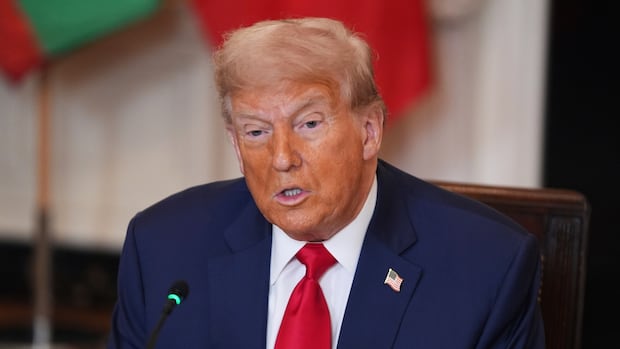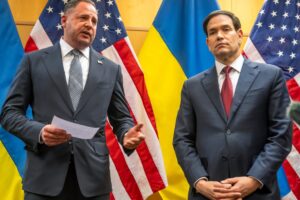
U.S. President Donald Trump on Saturday announced he’s levying tariffs of 30 per cent against the European Union and Mexico starting on Aug. 1, after weeks of negotiations with the key trading allies failed to reach a more comprehensive trade deal.
The fresh tariffs were announced in separate letters posted on Truth Social on Saturday.
Earlier this week, Trump issued new tariff announcements for a number of countries, including Canada, Japan, South Korea and Brazil, as well as a 50 per cent tariff on copper. The EU had hoped to reach a comprehensive trade agreement with the U.S. for the 27-bloc.
In his letter to Mexico’s leader, Trump acknowledged the country has been helpful in stemming the flow of undocumented migrants and fentanyl into the United States.
But he said Mexico has not done enough to stop North America from turning into a “Narco-Trafficking Playground.”
In his letter to the European Union, Trump said the U.S. trade deficit was a national security threat.
“We have had years to discuss our Trading Relationship with The European Union, and we have concluded we must move away from these long-term, large, and persistent, Trade Deficits, engendered by your Tariff, and Non-Tariff, Policies, and Trade Barriers,” Trump wrote in the letter to the EU. “Our relationship has been, unfortunately, far from Reciprocal.”
Cross Country Checkup is asking: What grade are you giving Prime Minister Mark Carney so far? Leave your comment here and we may read it or call you back for our show on Sunday.
In response to Trump’s latest tariff announcement, Mexico’s Economy Ministry said a bilateral working group aims to reach an alternative to the 30 per cent tariffs before they take effect.
Mexico was informed by the U.S. that it would receive a letter about the tariffs, the ministry’s statement said, adding that Mexico was negotiating.
WATCH | PM Carney responds to latest Trump tariff threat:
Carney resets deadline for U.S. trade deal to Aug. 1 after Trump tariff threat
Prime Minister Mark Carney responded to U.S. President Donald Trump’s latest threat to impose a 35 per cent tariff on all Canadian goods, saying the ‘revised deadline’ for a deal is Aug. 1 and that ‘Canada has made vital progress to stop the scourge of fentanyl.’
Ursula von der Leyen, president of the European Commission, the EU’s main executive body, spoke of the impact Trump’s tariffs would have on the production and distribution of goods.
“Imposing 30 per cent tariffs on EU exports would disrupt essential transatlantic supply chains, to the detriment of businesses, consumers and patients on both sides of the Atlantic,” she said.
“The EU has consistently prioritized a negotiated solution with the U.S., reflecting our commitment to dialogue, stability and a constructive transatlantic partnership.
“We remain ready to continue working towards an agreement by Aug. 1. At the same time, we will take all necessary steps to safeguard EU interests, including the adoption of proportionate countermeasures if required.”
Trump is in the midst of an announcement blitz of new tariffs with allies and foes alike, a bedrock of his 2024 campaign that he said would set the foundation for reviving a U.S. economy he claims has been ripped off by other nations for decades.
With the reciprocal tariffs, Trump is effectively blowing up the rules governing world trade.
WATCH | About That explores whether ‘Trump Always Chickens Out’ (TACO):
Does ‘Trump Always Chicken Out’? (TACO) | About That
U.S. President Donald Trump’s unpredictable tariffs have led many to describe his trade policy with the acronym TACO, short for “Trump Always Chickens Out”. But is he actually chickening out — or is it a negotiating tactic? Andrew Chang looks at what Trump may gain — and lose — by backing off from his most extreme policies.
Images provided by Getty Images, The Canadian Press and Reuters.
For decades, the United States and most other countries abided by tariff rates set through a series of complex negotiations known as the Uruguay round. Countries could set their own tariffs, but under the “most favoured nation” approach, they couldn’t charge one country more than they charged another.
With Saturday’s letters, Trump has now issued tariff conditions on 24 countries and the EU.
How tariffs will work under CUSMA
Earlier this week, a Trump administration official told CBC News that the 35 per cent tariff threat on imports from Canada won’t apply to goods that comply with the Canada-U.S.-Mexico Agreement (CUSMA).
The president posted about the 35 per cent levies on Truth Social. They’re expected to apply to goods currently hit with tariffs of 25 per cent, the official said.
U.S. tariffs on potash and energy are expected to remain at 10 per cent. However, no final decisions have been made by Trump.
WATCH | Trump calls CUSMA a ‘good deal’ during Carney meeting in May:
Trump calls CUSMA ‘a good deal for everybody’
In an Oval Office meeting with Prime Minister Mark Carney, U.S. President Donald Trump accused the previous Trudeau government of ‘trying to take advantage’ of the Canada-U.S. Free Trade Agreement, saying although the deal is ‘good for all countries,’ it will be up for renegotiation soon. Carney said the deal is a basis for a broader negotiation and some things about it will have to change.
The EU’s chief trade negotiator said earlier this week that a trade deal to avert higher tariffs on European goods imported to the U.S. could be reached “even in the coming days.”
Maroš Šefčovič told EU lawmakers in Strasbourg, France, on Wednesday that the EU had been spared the increased tariffs contained in the letters Trump sent on Monday and an extension of talks would provide “additional space to reach a satisfactory conclusion.”
The bloc collectively sells more to the U.S. than any other country. U.S. goods imports from the EU topped $553 billion US in 2022, according to the Office of the U.S. Trade Representative.
Insight into Trump’s letters
On April 2, Trump proposed a 20 per cent tariff for EU goods and then threatened to raise that to 50 per cent after negotiations didn’t move as fast as he would have liked. Šefčovič did not mention any tariff figures.
The higher tariffs as well as any EU retaliation had been suspended as the two sides negotiate. However, the base rate of 10 per cent for most trade partners, as well as higher rates of 25 per cent on autos and 50 per cent on steel and aluminum, had gone into effect.
Douglas Holtz-Eakin, a former congressional budget office director and president of the centre-right American Action Forum, said Trump’s letters were evidence that serious trade talks were not taking place over the past three months. He stressed that nations were instead talking amongst themselves about how to minimize their own exposure to the U.S. economy and Trump.
“They’re spending time talking to each other about what the future is going to look like, and we’re left out,” Holtz-Eakin said.
He added that Trump was using the letters to demand attention, but, “in the end, these are letters to other countries about taxes he’s going to levy on his citizens.”





